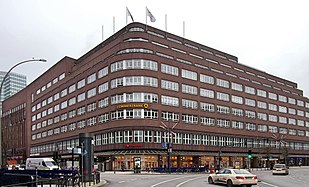Deutschlandhaus (Hamburg)
The Deutschlandhaus on Gänsemarkt in Hamburg was built from 1928 to 1929 based on designs by Fritz Block and Ernst Hochfeld . The building was originally used as an office building and was therefore one of Hamburg's office buildings . In addition to the office space, the building included a large movie theater, a department store and shopping malls. The Ufa-Palast , which no longer exists today, was one of the largest cinemas in Europe with around 2,700 seats. The striking eight-storey building was constructed using a steel frame construction; the brick facade was divided horizontally by means of continuous ribbon windows. The Deutschlandhaus was one of the few surviving early modern buildings of this type in Germany, but was not a listed building . The building was demolished in 2019.
Usage history and conversions
The Deutschlandhaus burned down in part after air raids in the Second World War in 1944. From 1946 to 1949, the British occupying forces rebuilt the confiscated house, with structural changes being made, and renamed it Hamburg House . The destroyed cinema was not restored, but removed. After the renovation, the British used the building for accommodation and supplies for their staff, including dance halls and kitchens. In 1952 the British authorities moved out, the NAAFI only used one floor completely and two more partially. The building was now called the Deutschlandhaus again.
From 1975 to 1978 the wing of the building, which was completely destroyed in the war, was rebuilt as a rotating track; the architect responsible was Heinz Schudnagies from Dietrich & Partner. In the second construction phase from 1979 to 1982, the remaining tracts were also rebuilt. The modernization is considered to be unsuccessful from a historical and aesthetic point of view, among other things, the window profiles were coarsened and the original clinker brick facade on the bay edge was completely replaced by bricks with a rustic hand-painted look.
demolition
In October 2017, demolition and new construction plans were announced for the house, which were pursued according to the first plans of the architect Hadi Teherani and were concretized in the course of 2018. The art historian Iris Wenderholm criticized the demolition of a "historically and town-planning important, identity-creating building" as a scandal. The demolition was carried out in 2019, the new building is scheduled to begin in 2020.
literature
- Roland Jaeger, Jörg Schilling: Das Deutschlandhaus 1929–2019 . Hamburg construction booklet No. 25, Schaff-Verlag, Hamburg 2018, ISBN 978-3-944405-40-7 .
- Roland Jaeger: Block and Hochfeld. The architects of the Deutschlandhaus. Buildings and projects in Hamburg 1921–1938 . Gebr. Mann, Berlin 1996, ISBN 3-7861-1802-7 .
- The Deutschlandhaus in Hamburg . In: Zentralblatt der Bauverwaltung . Vol. 51, No. 21 (May 27, 1931), pp. 301–306, 17 illustrations, urn : nbn: de: kobv: 109-opus-61016
Web links
Individual evidence
- ↑ Mc .: Germany house again . In: Hamburger Abendblatt , October 21, 1952, p. 5.
- ^ Ralf Lange : Architectural Guide Hamburg . Edition Menges, Stuttgart 1995, ISBN 3-930698-58-7 , p. 52. (Entry A 108: Deutschlandhaus )
- ↑ Jörn Lauterbach: Controversial new building: A palm atrium on Gänsemarkt . Welt Online , September 7, 2018
- ↑ Iris Wenderholm : Demolition of the Deutschlandhaus: Removal of an identity . In: FAZ , February 14, 2018.
- ↑ Eva Eusterhus: Devastation according to plan . Welt Online , August 2, 2019.
Coordinates: 53 ° 33 ′ 22 " N , 9 ° 59 ′ 15" E

